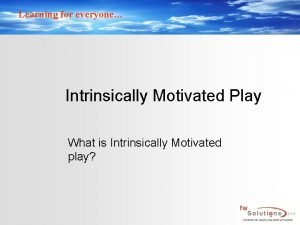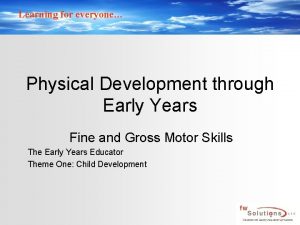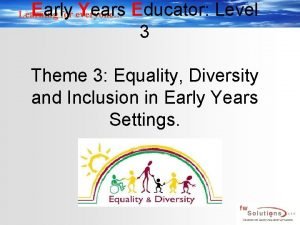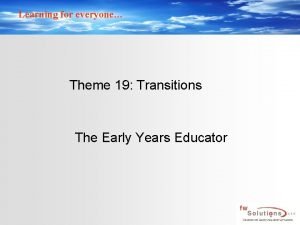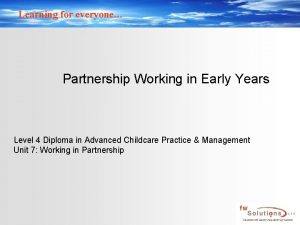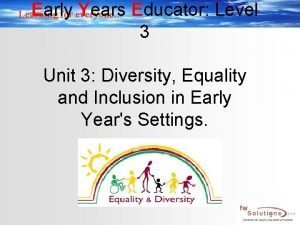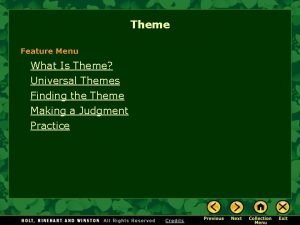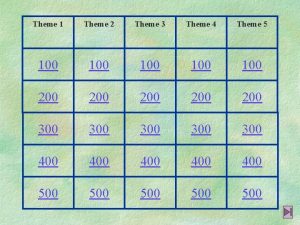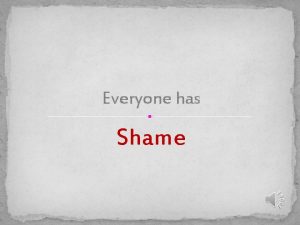Learning for everyone Theme 11 The Roles and











- Slides: 11

Learning for everyone… Theme 11 – The Roles and Responsibilities of the EYP Understand legislation and statutory guidance for practice in the early years

Learning for everyone… Understand Legislation linked to Childcare ‘Equality Act 2010’ This act provides Britain with a discrimination law which protects individuals from unfair treatment and promotes a fair and more equal society. The nine main pieces of legislation that have merged are: the Equal Pay Act 1970. the Sex Discrimination Act 1975 The 9 protected characteristics under the Equality Act 2010 are; age, disability, gender reassignment, race, religion or belief, sexual orientation, marriage and civil partnership and pregnancy and maternity. These are now called `protected characteristics´.

Learning for everyone…

Learning for everyone… Equality in Childcare Ø Attending a high quality inclusive setting can help support young children who are at risk of, or have faced inequality and discrimination. Ø To be an inclusive provider early years settings have to be proactive at removing the factors which act as barrier to inclusion such as negativity, bias and stereotyping. This takes a whole group approach to develop positive attitudes, implement clear strategies and nurture collaborative approaches. Ø Effective inclusive practice provides all children with access to opportunities and support during the earliest and most influential years of their learning and growing. It also helps enable children to be confident in who they are and what they aspire to in the future. Ø Early years settings are well placed to provide a safe environment where parents, staff and children can learn about each other’s differences and similarities and learn to empathise

Learning for everyone… Diversity in Early Years Ø Creating a cultural diversity environment is important in meeting the needs of all children within the setting. Children that attend Early Years settings often come from a wide range of cultures and backgrounds. Practitioners must support the beliefs and values of each child through a diverse environment Ø Diversity means the differences between individuals and groups in society arising from gender, ethnic origins, social, cultural or religious background, family structure, disabilities, sexuality and appearance. Ø Diversity means understanding that each individual is unique, and recognizing our individual differences. These can be along. the dimensions of race, ethnicity, gender, sexual orientation, socio-economic status, age, physical abilities, religious beliefs, political beliefs, or other ideologies.

Learning for everyone… ‘Inclusion’ early years involves: Simply put, childcare inclusion means that ‘Inclusive provision is open and accessible to all, and takes positive action in removing disabling barriers so that disabled and non-disabled children can participate. ’ Key Features of Inclusive Settings Include: Ø Activities are led by the interests and enthusiasms of each child who attends and take place with regard to any likes, dislikes and specific needs each child may have. Ø The person in charge is committed to the active participation of children, parents/carers, team members and others to ensure good quality provision and to ensure each individual’s needs are met Ø All practitioners have had attitudinal training around disability and other equality issues and continue to take part in training about inclusion. Ø The service has a vision of what it wants to do; policies and procedures for how it does it; and a process of monitoring and

Learning for everyone… ‘Discrimination’ Ø Discrimination is simply not understanding and following the ‘protected characteristics’ spoken about earlier in this presentation. Ø Discrimination is also seen as ‘having favourites’ and not treating all children the same when attending nursery Ø Discrimination is not accepting children from all races, backgrounds and religions Ø Discrimination is not involving all children equally in all activities Ø Discrimination is not upholding the acts of Parliament that are written to ensure children are safe, secure and treated equally at all times. Refer to the UN convention of Rights

Learning for everyone… ‘UN Convention of Rights’ This convention was adopted by the UN General Assembly in 1989 and is the most widely adopted international human rights treaty in history. The UK ratified the CRC in 1991. The convention has a total of 45 rights dedicated to the freedom, support, health and well being of children Please access a full copy of this in Theme 11 of your Study Area

Learning for everyone… The UN Convention of Rights ‘UN Convention of Rights’

Learning for everyone… The UN Conventi on of Rights

Learning for everyone… Introducing the Early Years Foundation Stage The framework that all early years childcare settings must adhere to is known as ‘The Early Years foundation Stage Curriculum’ (EYFS) The Childcare Act Section 39(1) (a) 2006 This stipulates that ‘early years providers’ must ensure that their provision meets the learning and development requirements as specified in the EYFS (Learning and Development Requirements) Order 2007 (amended in 2012). The act states that this order can specify the arrangements required for assessing children for the purpose of ascertaining what they have achieved in relation to the Early Learning Goals. (ELGs) Please ensure you have access to a copy of the EYFS handbook!
 I hope you are doing well formal
I hope you are doing well formal Cuadro comparativo e-learning y b-learning
Cuadro comparativo e-learning y b-learning Motivated learning for everyone
Motivated learning for everyone Early learning for everyone
Early learning for everyone Early learning for everyone
Early learning for everyone Early learning for everyone
Early learning for everyone Early learning for everyone
Early learning for everyone Early learning for everyone
Early learning for everyone What is the difference between genre and theme
What is the difference between genre and theme What is the difference between theme and universal theme?
What is the difference between theme and universal theme? Formuö
Formuö Typiska novell drag
Typiska novell drag


